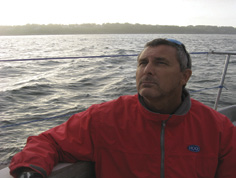
Anyone reading this ought to join me in giving Charlie Enright a big round of applause. Who? Unless you follow the vagaries of the high-test ocean racing world, or live in Newport or Bristol, RI, you are probably wondering if this Enright guy is Red Sox or Yankees? By proximity he is Red Sox, but that is irrelevant. So then, why am I applauding? Two reasons: a) He has managed to pull off a lifetime dream in seven years, and; b) That dream is sailing in the Volvo Ocean Race as skipper of the only real live U.S.-crewed boat in the VOR in a long time. (The boat is sponsored by Alvimedica, a medical technology company based in Turkey.) Did I mention he is 29?
In my very first WindCheck column 18 months ago, I wrote about the dearth of U.S. sailors in the VOR in general, so Enright’s breakthrough is particularly heartening to see. It’s another example of well-prepared people making their own luck. Enright, from Bristol (sheesh – where else?), came out of the junior sailing program at Bristol Yacht Club, sailed at Brown University, and was a collegiate All-American sailor four times. He has gone on to sail a lot of ocean racing miles since graduating. What really interests me about this bloke is his interest in introducing American kids to the genus of sailing many of them are not exposed to: bigger boats, maybe offshore racing or maybe not, but another way to sail not limited to dinghies.
There is an increasing amount of discussion, emailing, coffee & beer drinking, and general bubbling to the surface of ways to get young sailors (use high school as the definition for now) exposed to the idea that there is more to sailing than reaching across the bay in a 420 (or 4-Niner for that matter) getting wet and sunburnt. There are other ways to become a great, a successful, a well known, or maybe even a professional sailor besides the Olympics.
Anecdotally, the stories of burnout in the yacht club standard Opti-420 cohort are legion and the consensus is that there is a 90% dropout rate among college sailors after graduating. Whatever the number or reason, if there is to be a future for sailing in all its colors—clubs, members, fun, manufacturers, builders, sail makers, riggers, and so on—there needs to be a supply of young people getting interested in sailing, outside of dinghies.
Are you thinking, “Why should I care about kids and big boats?” Well, if you are a member of a yacht club and you are not caring about getting young sailors out on big boats, go and speak with the club’s treasurer or bookkeeper. On the one hand, many yacht clubs find themselves with an aging membership. At the supply end of this process, there are fewer members coming in than going out, as it were. The fixed costs for clubs continue to go up and the remaining membership is willing to pay only so much. The clubs are the rock and the two ends of the membership channel are the hard place. Oh, and have you tried to find crew lately?
I coach a high school team with 29 members. At least half a dozen of them are interested in anything that introduces them to sailing outside of the dinghies. Sailing does not have to be all drills and racing. If it is fun first, so kids want to remain doing it, then the ones who want to can push themselves and the rest can have a lifestyle, a sport, a family activity they can do until at least 82—the age of a mate of mine still cruising in the South Pacific.
My challenge to you all? Get a few like-minded souls together and figure out your own way to have kids sail with you. If you want some ideas, I have lots to share if you contact me. If you do it right, there will be incoming members to join your club, you will have a supply of young, keen, fit, and fairly skilled sailors to draw from for crew, the club dues will not increase as fast, and frankly you will have a hoot seeing those teenagers you trained, mentored and nurtured grow up to be all sorts of sailors. Some of ‘em might even end up like Charlie Enright.




